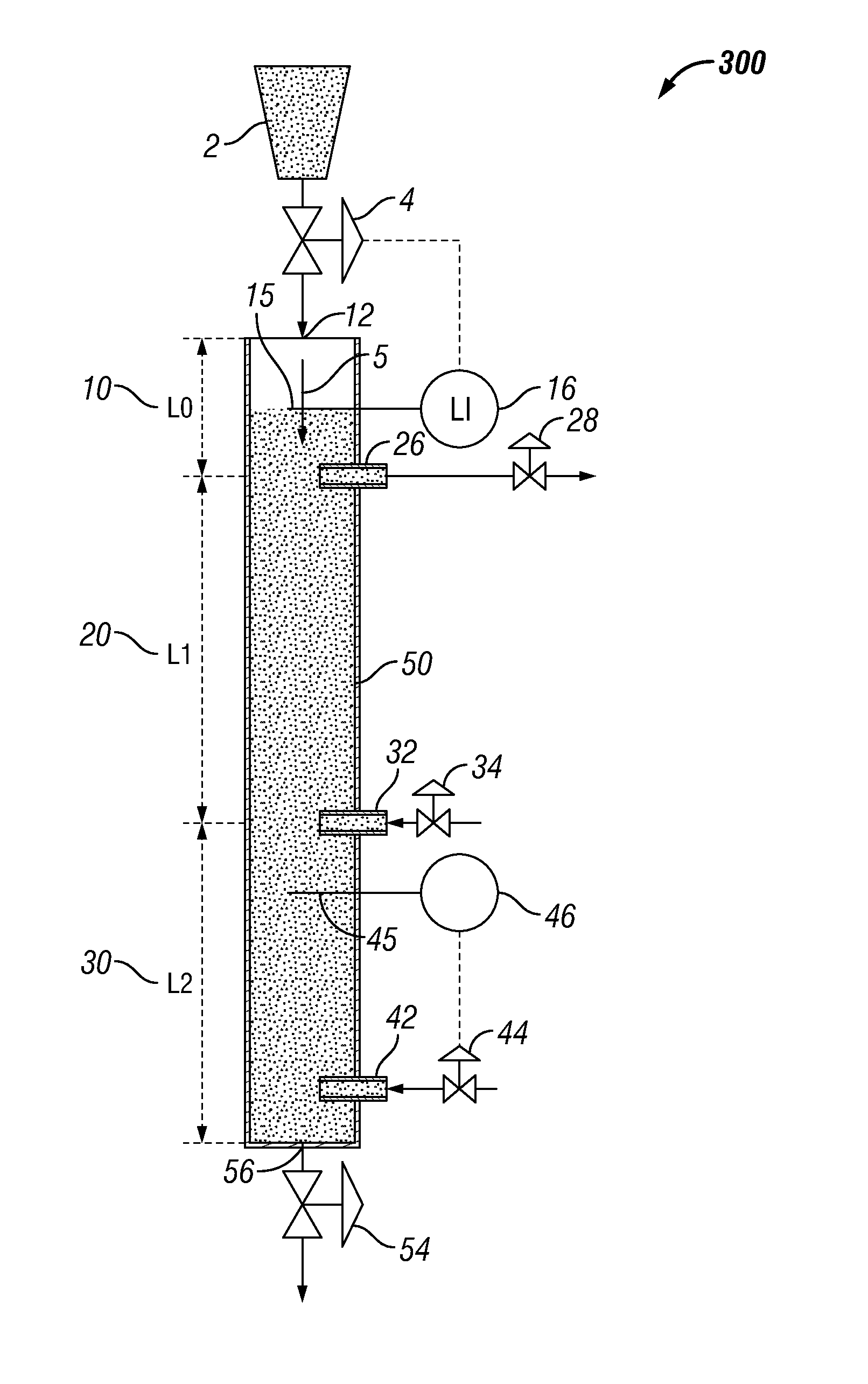Continuous or semi-continuous biomass wash system for hydrothermal hydrocatalytic conversion
a biomass wash and hydrocatalytic technology, applied in the direction of hydrocarbon oil treatment products, cleaning processes and apparatuses, cleaning using liquids, etc., can solve the problems of difficult penetration of lignocellulose biomass structure with chemicals, difficult to break down the long chain polymer structure of cellulose into carbohydrates that can be used to produce fuel, etc., to reduce the effectiveness of hydrothermal hydrocatalytic treatment, avoid excess loss of solvent, and minimize the amount of water used
- Summary
- Abstract
- Description
- Claims
- Application Information
AI Technical Summary
Benefits of technology
Problems solved by technology
Method used
Image
Examples
example 1
[0122]A 25-mm Adjust-a-Chrom×450-mm glass chromatography column was charged with a 9-inch bed of ground pine wood with moisture content of 59.9%, measured by drying of a sample in a vacuum oven overnight at 86 C. 16.8 grams of wood were charged on a dry basis.
[0123]De-ionized water with or without added sulphuric acid was charged as solvent to a feed buret. The solvent was flowed upflow through the column at 1.02 ml / min using a Low-Flow Compact Metering Pump, 30 mL / min maximum, 115 VAC, from Cole Parmer (WU-07115-10). A retriever 500 fraction collector from Isco / Teledyne was used to collect sample fractions. Southeaster US pine wood was ground to a dimension of approximately 8-mm×3-mm×3-mm using a “Retsch Cutting Mill” Model SM100 is a rotating knife blade grinder.
[0124]Liquid effluent samples were collected in 15-ml fractions and analyzed for chloride removal via ion chromatography, and for metals via plasma emission spectroscopy. Final wood samples following treatment were analyze...
example 2
[0127]Example 1 was repeated with only 3 bed volumes of de-ionized water as the treatment solvent. Maximum chloride in effluent samples was 22 ppm. Final wood analysis indicated removal of 60% of the initially present chloride and more than 45% of magnesium and calcium originally present. Manganese and iron removal were negligible. These examples show that water wash of biomass at a treatment rate of 0.6 bed volumes per hour is effective in removal of chloride, as well as metal salts such as magnesium and calcium salts. Treatment with water-only as wash solvent removed chloride was as effectively as acid wash followed by water wash. Magnesium and calcium salts were also effectively remove by water-only wash treatment. Transition metals manganese and iron were not effectively removed by water, but required addition of acid.
example 3
[0128]A 15-mm inside diameter×24 inch glass chromatography column was charged with 23 inches of ground pine wood with moisture content of 52.4%, measured by drying of a sample in a vacuum oven overnight at 86° C. 39.6 grams of wood were charged. Ethanol (less than 1000 ppm H2O) was charged as solvent to a feed buret. The solvent was flowed upflow through the column at 0.8 ml / min using a Low-Flow Compact Metering Pump, 30 mL / min maximum, 115 VAC, from Cole Parmer (WU-07115-10). A retriever 500 fraction collector from Isco / Teledyne was used to collect sample fractions. Southeaster US pine wood was ground to a dimension of approximately 8-mm×3-mm×3-mm using a “Retsch Grinder” Model SM100 is a rotating knife blade grinder.
[0129]Samples were collected in 50-ml fractions (0.48 bed volumes MVP, and analyzed by Karl Fisher titration for water content. At the end of 3.9 bed volumes of solvent wash, the cumulative water removed corresponded to 103% of the assessed water content ...
PUM
| Property | Measurement | Unit |
|---|---|---|
| velocity | aaaaa | aaaaa |
| velocity | aaaaa | aaaaa |
| length | aaaaa | aaaaa |
Abstract
Description
Claims
Application Information
 Login to View More
Login to View More - R&D
- Intellectual Property
- Life Sciences
- Materials
- Tech Scout
- Unparalleled Data Quality
- Higher Quality Content
- 60% Fewer Hallucinations
Browse by: Latest US Patents, China's latest patents, Technical Efficacy Thesaurus, Application Domain, Technology Topic, Popular Technical Reports.
© 2025 PatSnap. All rights reserved.Legal|Privacy policy|Modern Slavery Act Transparency Statement|Sitemap|About US| Contact US: help@patsnap.com



